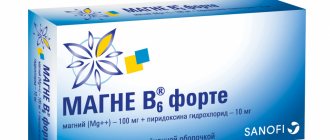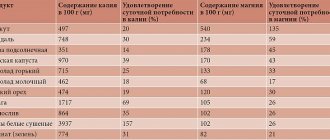Magne B6 Forte tablets p/o 100mg/10mg No. 20x2
Name
Magne in 6 forte.
Release forms
Tablets.
INN
Magnesium citrate + pyridoxine hydrochloride.
Compound
1 tablet contains: active ingredients: magnesium citrate – 618.43 mg, which corresponds to 100 mg of magnesium (Mg++), pyridoxine hydrochloride – 10 mg; excipients: anhydrous lactose, macrogol-6000 (E1521), magnesium stearate (E572), hypromellose 6 mPa.s (E 464), titanium dioxide (E171), talc (E553).
Description
White oval film-coated tablets.
Pharmacotherapeutic group
Mineral supplements. Magnesium-based products. ATX code: A12CC.
Pharmacological properties
Pharmacodynamics
Physiological aspects: Magnesium is predominantly an intracellular cation. Magnesium reduces the excitability of neurons, participates in neuromuscular synaptic transmission, muscle contraction and regulation of enzymatic processes. Magnesium is a macronutrient; half of the magnesium contained in the body accumulates in bone tissue. Clinical aspects: Serum magnesium levels: - between 12 and 17 mg/L (1-1.4 mEq/L or 0.5-0.7 mmol/L): indicate mild magnesium deficiency - below 12 mg/L ( 1 mEq/L or 0.5 mmol/L): indicates severe magnesium deficiency. The deficiency can be: - primary, due to a congenital abnormality of metabolism (chronic congenital hypomagnesemia), - secondary, due to - inadequate intake (severe malnutrition, alcoholism, exclusively parenteral nutrition), - disorders of gastrointestinal absorption (chronic diarrhea, gastrointestinal - intestinal fistula, hypoparathyroidism), - excessive losses at the renal level (tubular disease, severe polyuria, diuretic abuse, chronic pyelonephritis, primary hyperaldosteronism, treatment with cisplatin). Pyridoxine (vitamin B6) is involved in many metabolic processes, including the nervous system. Vitamin B6 improves the absorption of magnesium from the gastrointestinal tract and its penetration into cells.
Pharmacokinetics
Gastrointestinal absorption of magnesium salts occurs partly through a passive mechanism in which the solubility of the salt plays a determining role. The degree of this absorption does not exceed 50%. Excretion occurs primarily through urine.
Indications for use
This medicine contains magnesium. A combination of the following symptoms may indicate a magnesium deficiency: - Nervousness, irritability, mild anxiety, transient fatigue, minor sleep disturbances, - Signs of anxiety such as gastrointestinal cramps or rapid heartbeat (if the heart is healthy), - Muscle cramps, pins and needles sensation skin Magnesium supplementation may help relieve these symptoms. If no improvement is observed after one month of treatment, continuation of monotherapy with this drug is not advisable.
Contraindications
The use of the drug is contraindicated in the following cases: - hypersensitivity to one of the components (see section "Composition") - severe renal failure (creatinine clearance less than 30 ml/minute)
Directions for use and doses
The tablets should be taken whole with a glass of water. Adults: 3-4 tablets per day, divided into 2-3 doses, with meals. Children over 6 years of age (about 20 kg): 10-30 mg/kg/day (0.4-1.2 mmol/kg/day), i.e. 2-4 tablets per day, divided into 2-3 doses , while eating. Typically the duration of treatment is one month.
Side effect
Adverse reactions that may occur when using the drug are classified according to systemic organ classes and frequency, indicated as: very often (≥ 1/10), often (≥ 1/100, but
Special instructions and precautions
In case of concomitant calcium deficiency, magnesium deficiency must be corrected before using calcium supplements. Due to the presence of lactose in the tablets, the drug should not be taken if you have galactose intolerance, impaired absorption of glucose or galactose, or lactase deficiency. Excessive consumption of pyridoxine can cause sensory neuropathy, which occurs with long-term use of pyridoxine and/or chronic use of high doses of pyridoxine over a long period of time (several months or years). This condition gradually goes away after stopping treatment with the drug (see Section “Overdose”) TABLETS ARE INTENDED FOR ADULTS AND CHILDREN OVER 6 YEARS OLD. There are dosage forms that are more suitable for children under 6 years of age. In moderate renal impairment, caution should be exercised to avoid the risk associated with hypermagnesemia.
Overdose
Magnesium Overdose Oral magnesium overdose does not usually cause toxic reactions if the kidneys are functioning normally. However, magnesium poisoning can develop in cases of kidney failure. Toxic effects depend on the level of magnesium in the blood, and their symptoms are as follows: - drop in blood pressure - nausea, vomiting - depression of the central nervous system, decreased reflexes - ECG abnormalities - respiratory depression, coma, cardiac arrest and respiratory paralysis - anuric syndrome. Treatment: rehydration, forced diuresis. In case of renal failure, hemodialysis or peritoneal dialysis is necessary. Pyridoxine overdose Sensory axonal neuropathy is the main effect that can occur with long-term and/or chronic use of high doses of pyridoxine (over several months or years). Signs and Symptoms Specifically, the following symptoms have been reported: paresthesia, dysesthesia, hypoesthesia, sensory deficits, pain in the extremities, involuntary muscle contractions, burning sensation, imbalance, unsteadiness of gait, tremors in the arms and legs, and progressive sensory ataxia (difficulty coordinating movements). ). Treatment: neurological symptoms are reversible and gradually disappear after stopping treatment with the drug.
Pregnancy and lactation
Pregnancy If necessary, magnesium can be used at any stage of pregnancy. Although large-scale studies are lacking, available clinical experience is encouraging. Breastfeeding The use of magnesium and vitamin B6 contained in the drug is considered compatible with the lactation period. The maximum recommended dose of vitamin B6 during breastfeeding is no more than 20 mg per day. Exceeding this dose is not recommended.
Interaction with other drugs and other forms of interaction
Combinations not recommended - Phosphate or calcium salts These substances interfere with the absorption of magnesium in the intestines.
Impact on the ability to drive vehicles or other machinery
There are no special recommendations.
Package
20 tablets in blisters (made of PVC-PE-PVDC/aluminum), two blisters in a cardboard box along with instructions for medical use.
Storage conditions
Store at a temperature not exceeding 30°C. Keep out of the reach of children. Read the instructions carefully before use.
Best before date
2 years. Do not use after the expiration date stated on the package.
Conditions for dispensing from pharmacies
Available without a prescription.
Buy Magne B6 Forte tablet, coated. captivity. vol., 100 mg/10 mg per blister. in pack No. 20x2 in the pharmacy
Price for Magne B6 Forte tablet, coated. captivity. vol., 100 mg/10 mg per blister. in pack №20x2
Instructions for use for Magne B6 Forte tablet, coated. captivity. vol., 100 mg/10 mg per blister. in pack №20x2
Magne B6 forte for magnesium and vitamin B6 deficiency tablets No. 40
A country
Hungary
The country of production may vary depending on the batch of goods. Please check with the operator for detailed information when confirming your order.
Compound
1 tablet contains the core of the tablet: active ingredients: magnesium citrate - 618.43 mg, which corresponds to 100 mg of magnesium (Mg++), pyridoxine hydrochloride - 10.00 mg; excipients: lactose - 50.57 mg, macrogol-6000 - 120.00 mg, magnesium stearate - 1.00 mg. Tablet shell: hypromellose 6 mPa.s - 14.08 mg, macrogol-6000 - 1.17 mg, titanium dioxide (E 171) - 4.75 mg, talc - traces. Description Oval, biconvex, white film-coated tablets. At the fracture, two layers are visible: a white shell and a white tablet mass. Release form: Film-coated tablets. 15 or 20 tablets in a blister made of PVC-PE-PVDC/aluminum foil. 2 or 4 blisters of 15 tablets each, 2 or 3 blisters of 20 tablets each, along with instructions for use in a cardboard box.
Pharmacological properties
Pharmacodynamics Magnesium is a vital element that is necessary for the normal functioning of cells and is involved in most metabolic reactions. In particular, it is involved in the regulation of the transmission of nerve impulses and muscle contraction. 1/3 of the amount of magnesium contained in the body accumulates in bone tissue. The body receives magnesium through food. A lack of magnesium in the body can be observed when the diet is disrupted, when the need for magnesium increases, or when there is an imbalance in the intake, metabolism and excretion of magnesium (for example, with increased physical and mental stress, stress, during pregnancy, when using diuretics). Pyridoxine (vitamin B6) is involved in many metabolic processes and helps improve the absorption of magnesium from the gastrointestinal tract and its penetration into cells. Serum magnesium levels: - between 12 and 17 mg/L (1 - 1.4 mEq/L or 0.5 - 0.7 mmol/L): indicate mild magnesium deficiency; - below 12 mg/L (1 mEq/L or 0.5 mmol/L): indicate severe magnesium deficiency. Pharmacokinetics Gastrointestinal absorption of magnesium salts occurs partly through a passive mechanism in which the solubility of the salt plays a determining role. The degree of this absorption does not exceed 50%. Excretion occurs mainly by the kidneys.
Indications for use
Established magnesium deficiency, isolated or associated with other deficiency conditions, accompanied by symptoms such as increased irritability, minor sleep disturbances, gastrointestinal cramps, rapid heartbeat, increased fatigue, muscle pain and spasms, and a tingling sensation in the muscles. If after a month of treatment there is no improvement in these symptoms, continuing treatment is not advisable.
Contraindications
Hypersensitivity to any of the components of the drug. Severe renal failure (creatinine clearance less than 30 ml/min). Phenylketonuria. Age up to 6 years (efficacy and safety have not been established). Hereditary galactosemia, glucose and galactose malabsorption syndrome, or lactase deficiency (due to the presence of lactose in the drug). Concomitant use of levodopa (see “Interaction with other drugs”). With caution: Moderate renal failure (risk of developing hypermagnesemia). Use during pregnancy and breastfeeding Pregnancy Clinical experience with the drug in a sufficient number of pregnant women has not revealed any adverse effects on the occurrence of fetal malformations or fetotoxic effects. The drug Magne B6® forte can be used during pregnancy only if necessary, on the recommendation of a doctor. Breastfeeding period Taking into account that magnesium passes into breast milk, if it is necessary to take the drug, it is recommended to stop breastfeeding.
Mode of application
The tablets should be taken whole with a glass of water. Adults: 3-4 tablets per day, divided into 2-3 doses, with meals. Children over 6 years of age (weighing about 20 kg): 10-30 mg/kg/day (0.4–1.2 mmol/kg/day), i.e. children over 6 years of age (weighing about 20 kg) 2- 4 tablets per day, divided into 2-3 doses, with meals. Typically the duration of treatment is one month.
Side effect
Immune system disorders: Very rare (Gastrointestinal disorders: Unknown frequency (it is not possible to estimate the frequency of occurrence based on available data): diarrhea, abdominal pain, nausea, vomiting, flatulence.
Overdose
Symptoms With normal renal function, an overdose of magnesium when taken orally does not usually lead to toxic reactions. However, in case of renal failure, magnesium poisoning may develop. Symptoms of overdose, the severity of which depends on the concentration of magnesium in the blood: decreased blood pressure; nausea, vomiting; depression of the central nervous system, decreased reflexes; changes in the electrocardiogram; respiratory depression, coma, cardiac arrest and respiratory paralysis; anuric syndrome. Treatment Rehydration, forced diuresis. In case of renal failure, hemodialysis or peritoneal dialysis is necessary.
Interaction
Contraindicated combinations With levodopa: the activity of levodopa is inhibited by pyridoxine (unless taking this drug is combined with taking inhibitors of peripheral aromatic L-amino acid decarboxylase). Any amount of pyridoxine should be avoided unless levodopa is taken in combination with peripheral aromatic L amino acid decarboxylase inhibitors. Not recommended combinations The simultaneous use of drugs containing phosphates or calcium salts may impair the absorption of magnesium in the intestine. Combinations that should be taken into account When prescribing tetracyclines orally, it is necessary to maintain an interval of at least three hours between ingestion of tetracycline and Magne B6 forte, since magnesium preparations reduce the absorption of tetracyclines.
special instructions
The tablets are intended only for adults and children over 6 years of age. In case of moderate renal failure, the drug should be taken with caution due to the risk of developing hypermagnesemia. If calcium and magnesium are deficient at the same time, the magnesium deficiency should be corrected before taking calcium supplements or dietary supplements containing calcium. When pyridoxine is used in high doses (more than 200 mg per day) for a long time (over several months or in some cases years), sensory axonal neuropathy may develop, which is accompanied by symptoms such as numbness and impaired proprioceptive sensitivity, distal tremor limbs and gradually developing sensory ataxia (impaired coordination of movements). These disorders are usually reversible and disappear after stopping taking vitamin B6. Impact on the ability to drive vehicles and engage in other potentially hazardous activities No effect. There are no special recommendations.





